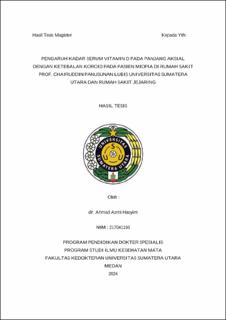| dc.contributor.advisor | Amra, Aryani Atiyatul | |
| dc.contributor.advisor | Delfi | |
| dc.contributor.author | Hasyim, Ahmad Azmi | |
| dc.date.accessioned | 2025-04-24T08:17:34Z | |
| dc.date.available | 2025-04-24T08:17:34Z | |
| dc.date.issued | 2024 | |
| dc.identifier.uri | https://repositori.usu.ac.id/handle/123456789/103400 | |
| dc.description.abstract | Introduction: The close relationship between changes in choroidal thickness (CT) and
changes in eye growth in humans indicates an important role of the choroid in the
mechanism of eye growth regulation and the occurrence of refractive disorders. Vitamin
D, with its role in regulating calcium metabolism and anti-inflammatory effects, may help
maintain choroidal thickness and prevent excessive structural changes in the eye
associated with axial elongation.
Methods: This study is an analytical study with a cross-sectional research design
approach so that measurements of axial length and choroidal thickness were measured at
a time to be determined after the patient was diagnosed with myopia at the Eye Clinic of
Prof. Dr. Chairuddin Panusunan Lubis Hospital and network hospitals in the Medan area
from June 2024 to August 2024. The data obtained will be analyzed using the Pearson
Correlation test if the data is normally distributed, if the data is not normally distributed
using the Spearman correlation test.
Results: This study was attended by 63 people with myopia, most of the subjects were
male, totaling 34 people (54%). The average age of the subjects was 24.37 years with the
youngest age being 20 years and the oldest being 36 years. The median vitamin D level
in the mild myopia group was 111 nmol/L, in the moderate myopia group the median
vitamin D level was 102 nmol/L and in the severe myopia group the lowest vitamin D
level was 98 nmol/L. The median axial length in the mild myopia group was 23.13 mm,
in the moderate myopia group the median axial length was 24.4 mm and in the severe
myopia group the longest axial length was 26.11 mm. The median choroidal thickness in
the mild myopia group was 291.31 μm, in the moderate myopia group the median
choroidal thickness was 290.41 μm and in the severe myopia group the thinnest choroidal
thickness was 273.26 μm on average. There is a significant correlation between vitamin
D levels and axial length (p<0.001) with a correlation value of -0.526 and Vitamin D
levels correlate significantly with choroidal thickness in all myopia patients without any
grouping based on the degree of myopia (p<0.001) with a correlation value of 0.501.
Conclusion: There is a moderate negative correlation between vitamin D levels and axial
length (p<0.001; r = -0.526) and a moderate positive correlation with choroidal thickness
(p<0.001; r = 0.503) in myopia as a whole | en_US |
| dc.language.iso | id | en_US |
| dc.publisher | Universitas Sumatera Utara | en_US |
| dc.subject | Myopia | en_US |
| dc.subject | Vitamin D | en_US |
| dc.subject | Axial Length | en_US |
| dc.subject | Choroidal Thickness | en_US |
| dc.title | Pengaruh Kadar Serum Vitamin D pada Panjang Aksial dengan Ketebalan Koroid pada Pasien Miopia di Rumah Sakit Prof. Chairuddin Panusunan Lubis Universitas Sumatera Utara dan Rumah Sakit Jejaring | en_US |
| dc.title.alternative | The Effect of Serum Vitamin D Levels on Axial Length with Chorioid Thickness in Myopia Patients at Prof. CPL Hospital, University of North Sumatera and Networking Hospitals | en_US |
| dc.type | Thesis | en_US |
| dc.identifier.nim | NIM217041160 | |
| dc.identifier.nidn | NIDN0002056403 | |
| dc.identifier.nidn | NIDN0022096703 | |
| dc.identifier.kodeprodi | KODEPRODI11103#Ilmu Kedokteran Klinis | |
| dc.description.pages | 115 Pages | en_US |
| dc.description.type | Tesis Magister | en_US |
| dc.subject.sdgs | SDGs 3. Good Health And Well Being | en_US |


